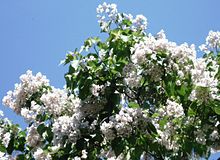
Catalpa, commonly also called catawba, is a genus of flowering plants in the family Bignoniaceae, native to warm temperate and subtropical regions of North America, the Caribbean, and East Asia.

Paulownia tomentosa, common names princess tree, empress tree, or foxglove-tree, is a deciduous hardwood tree in the family Paulowniaceae, native to central and western China. It is an extremely fast-growing tree with seeds that disperse readily, and is a persistent exotic invasive species in North America, where it has undergone naturalisation in large areas of the Eastern US. P. tomentosa has also been introduced to Western and Central Europe, and is establishing itself as a naturalised species there as well.
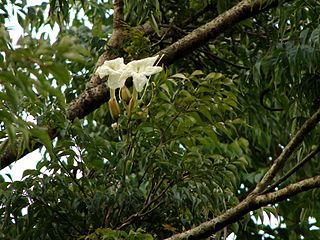
Radermachera sinica, also called china doll, serpent tree or emerald tree, is an evergreen tree in the family Bignoniaceae, native to the subtropical mountain regions of southern China and Taiwan.
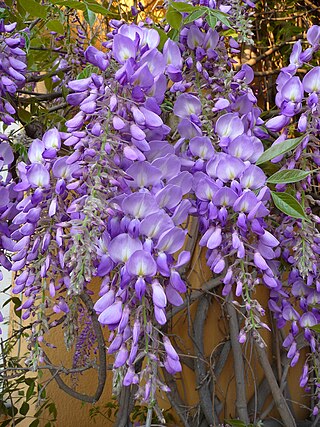
Wisteria sinensis, commonly known as the Chinese wisteria, is a species of flowering plant in the pea family, native to China, in the provinces of Guangxi, Guizhou, Hebei, Henan, Hubei, Shaanxi, and Yunnan. Growing 20–30 m (66–98 ft) tall, it is a deciduous vine. It is widely cultivated in temperate regions for its twisting stems and masses of scented flowers in hanging racemes, in spring.

Acer griseum, the paperbark maple or blood-bark maple, is a species of flowering plant in the family Sapindaceae, native to central China. Acer griseum is found in the Chinese provinces of Gansu, Henan, Hubei, Hunan, Shaanxi, Shanxi and Sichuan, at altitudes of 1,500–2,000 m (4,921–6,562 ft).

Catalpa speciosa, commonly known as the northern catalpa, hardy catalpa, western catalpa, cigar tree or catawba, is a species of Catalpa native to the midwestern United States.

Castanea mollissima, also known as the Chinese chestnut, is a species of chestnut tree in the family Fagaceae that is native to China, Taiwan, and Korea.

Catalpa bignonioides is a short-lived species of Catalpa that is native to the southeastern United States in Alabama, Florida, Georgia, Louisiana, and Mississippi. Common names include southern catalpa, cigartree, and Indian-bean-tree. It is commonly used as a garden and street tree.
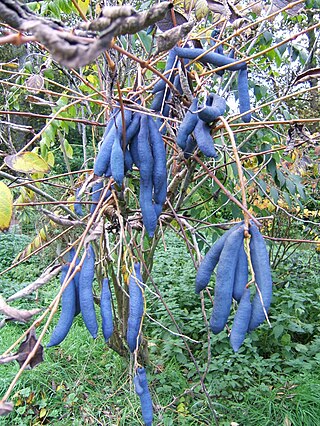
Decaisnea Hook.f &Thomson, known commonly as dead man's fingers, blue bean plant, or blue sausage fruit, is a genus of flowering plants in the family Lardizabalaceae. It is native to eastern Asia, from China west to Nepal and south to Myanmar.

Abies fargesii is a species of fir, a coniferous tree in the family Pinaceae. Its common name is Farges' fir, after the French missionary, botanist and plant collector, Paul Guillaume Farges. Abies fargesii can grow very large and be up to 40 metres (130 ft) tall. It is endemic to central China where it is found in Gansu, Henan, Hubei, Shaanxi, and Sichuan provinces. It grows in mountains and river basins at altitudes between 1,500–3,900 metres (4,900–12,800 ft) ASL. The cones of the given fir are 0.8 to 1.5 by 1.3–2 centimetres (0.51–0.79 in).
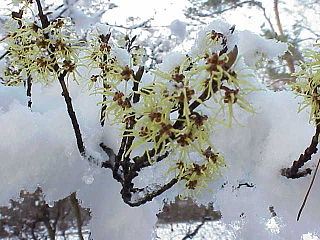
Hamamelis mollis, also known as Chinese witch hazel, is a species of flowering plant in the witch hazel family Hamamelidaceae, native to central and eastern China, in Anhui, Guangxi, Hubei, Hunan, Jiangxi, Sichuan, and Zhejiang.
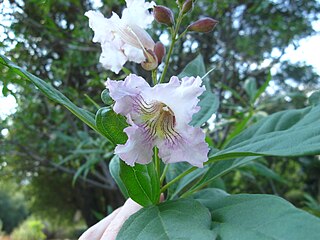
×Chitalpa is an intergeneric hybrid flowering tree in the family Bignoniaceae. There are two major forms in North America, the 'Morning Cloud' a hybrid of desert willow for desert hardiness and color, and northern catalpa, and the 'Pink Dawn' variety formed as a hybrid of desert willow and either yellow catalpa or northern catalpa. Both forms were originally thought to be hybrids of desert willow and southern catalpa. The name is nothogeneric, or a combination of the two parents' names. Leaves are lanceolate, 10 to 13 cm long and 2.5 cm (1 in) wide, almost always in whorls of three. The trumpet-shaped flowers are 2.5 cm (1 in) long and frilly. The inflorescence is indeterminate, with alternately arranged flowers.

Clerodendrum trichotomum, the harlequin glorybower, glorytree or peanut butter tree, is a species of flowering plant in the family Lamiaceae. It is native to China, Korea, Taiwan, Japan, India, and the Philippines.

Lilium fargesii is a Chinese species of plants in the lily family native to Hubei, Shaanxi, Sichuan and Yunnan provinces of China.
Torreya fargesii is a species of conifer in the family Taxaceae. It is a large tree that can be up to 20 metres (66 ft) tall. It is endemic to central and southern China; it is found in Hubei, Hunan, Jiangxi, Shaanxi, Sichuan, and Yunnan provinces, and possibly in Anhui. It occurs in coniferous, mixed, and broad-leaved forests at altitudes 1,000–3,400 metres (3,300–11,200 ft) ASL. The seeds can be pressed for oil. The wood is used in construction and furniture.

Iris lactea is a species in the genus Iris. It is also in the subgenus Limniris and is the only species in the series Ensatae. The Japanese water iris, Iris ensata, is actually in series Laevigatae. It is a rhizomatous perennial, from central Asia, with pale blue or violet flowers. It is cultivated as an ornamental plant in temperate regions.
Iris dolichosiphon is a plant species in the genus Iris, it is also in the subgenus Iris and in the section Pseudoregelia. It is a rhizomatous perennial, from China and Bhutan. It has long, thin dark green leaves, very short stem, and dark blue, purple, or violet flowers. That are mottled with white. It has thick white/orange beards. It has one subspecies, Iris dolichosiphon subsp. orientalis, from China, India and Burma. It has similar flowers. They are cultivated as ornamental plants in temperate regions
Castanopsis fargesii Is an evergreen tree that grows 10–30 m tall.

Salix fargesii (川鄂柳), the Farges willow, is a species of flowering plant in the willow family (Salicaceae), which is native to Gansu, Hubei, Shaanxi, and Sichuan in China. It inhabits mountainous areas at 1,400–1,600 m (4,600–5,200 ft).

Catalpa × erubescens, the hybrid catalpa, is a hybrid plant species of Catalpa in the family Bignoniaceae. It is a medium-sized tree, reaching at most 20 m. Its parents are southern catalpa, Catalpa bignonioides, from the United States, and yellow catalpa, C. ovata, from China. There is one accepted form, Catalpa × erubescens Carrière f. purpurea Paclt, which has purple, some say chocolate-colored, young leaves which turn green as they mature. This form is marketed under a variety of names, such as hybrid catalpa 'Purpurea', red-leaved Indian bean tree, and purple hybrid catalpa, and has gained the Royal Horticultural Society's Award of Garden Merit.
